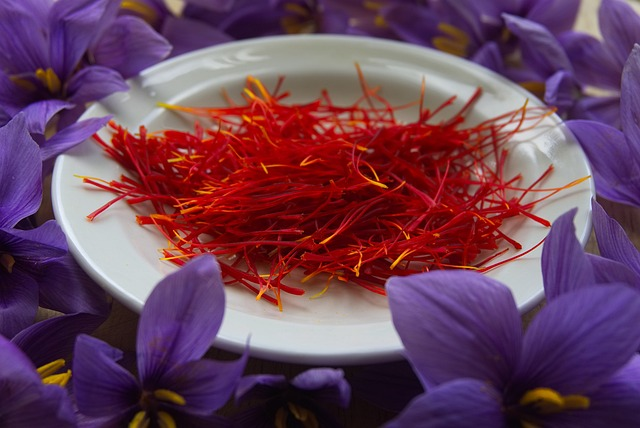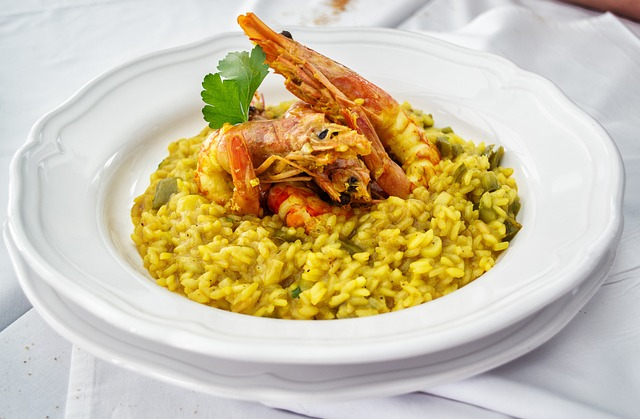What Does Saffron Taste Like: The Luxury of Exquisite Flavor

What does saffron taste like?
Saffron offers an unparalleled flavor profile that is both complex and unique. Upon first taste, it presents a slightly bitter hint, quickly mellowing to reveal a honey-like sweetness.
This interplay of flavors is punctuated by subtle, floral notes that lend a certain lightness to its taste. Overall, saffron tastes earthy, with grassy undertones that are reminiscent of the hay.
The flavor is distinct yet subtle, imbuing dishes with an exquisite complexity that is quite unlike any other spice. The lingering aftertaste of saffron, sweet and pleasantly aromatic, is what truly sets it apart, making every culinary experience with it truly memorable.
Nutritional Value of Saffron
When you consider investing in the world’s most expensive spice, you’re not just buying flavor. Saffron is a goldmine of nutrition as well. It is an excellent source of minerals such as iron, magnesium, and potassium, vital for various bodily functions.
Saffron is also rich in vitamin C and B6, which boosts your immune system and promotes brain health. With its high antioxidant properties, saffron aids in combating free radicals and reducing oxidative stress.
This luxurious spice offers not only taste but also well-being, making it a worthy addition to your kitchen.
Super Negin Saffron
In the world of saffron, different grades cater to different needs. However, Super Negin holds a place of honor. This grade is defined by long, thick threads with vibrant color, embodying the pinnacle of quality. It provides a more intense aroma, and its flavor is potent, offering an elevated experience both culinarily and health-wise.
Super Negin saffron allows you to explore the depth of saffron’s character in its richest form.
High-Quality Saffron Characteristics
The nuances of quality saffron are many. Deep red color with slightly lighter ends, a strong and fresh aroma, and threads that are dry but not brittle are all hallmarks of the finest saffron. On your tongue, quality saffron introduces a mild bitterness that transforms into a honey-like sweetness, creating a taste profile that’s hard to forget.
Where is Saffron from?
Saffron is derived from the flower of the Crocus sativus, commonly known as the “saffron crocus”. The word “saffron” comes from the Arabic word “za’faran,” which means yellow.
Historically, saffron was first cultivated in Greece, but its use quickly spread throughout the ancient world. Today, it is primarily produced in Iran, which accounts for approximately 90% of the world’s total saffron production. However, it’s also grown in other countries including India, Spain, Greece, Afghanistan, and Italy.
Despite its wide cultivation, saffron is one of the most expensive spices in the world due to its labor-intensive harvesting process. Each saffron flower produces only three stigmas, which must be handpicked and dried. It takes about 75,000 saffron flowers to produce a single pound of the spice, explaining its high cost.
But no matter where it is grown, saffron remains a treasured spice for its ability to infuse foods with its distinct color, flavor, and aroma, making it a highly sought-after commodity in the culinary world.
Where to Buy Saffron Threads
Given its high price point, purchasing saffron needs thoughtfulness and discretion. Specialty grocery stores and spice shops often carry high-quality saffron. Online, numerous reputable vendors offer saffron, but be careful of counterfeit or low-quality products. Always look for threads that are intact, deeply colored, and have a fresh aroma. Remember, high-quality saffron is an investment in taste and health.
Color Bleed
The intensity of saffron’s color bleed is a clear indication of its quality. When soaked in warm water, quality saffron threads will slowly release a captivating, golden-yellow color, infusing both the liquid and your dishes with an enticing hue. This color characteristic is not just aesthetic but also adds to the overall gastronomic experience.
Time To Discover Four Types Of Saffron
Saffron comes in different types, including Sargol, Pushal, Negin, and Konj or white saffron.
- Sargol is of the highest quality, containing only the red stigma tips.
- Pushal saffron is a blend of stigma and style, less potent but still flavorful.
- Negin saffron is a step below in quality, with shorter threads.
- Konj saffron is the lowest grade and is often used as a colorant.
How To Use Saffron In Recipes
Saffron is a versatile spice that adds depth and complexity to a wide range of dishes. From the classic risottos, paellas, and biryanis to desserts like saffron-infused ice cream or pudding, this spice enhances the flavors of any recipe. To use saffron, crush and soak the threads in warm liquid (water, milk, or broth) to release the flavor before adding it to your dish. Remember, a little goes a long way.
Saffron Rice

Ingredients:
- 1 cup of basmati rice
- 2 cups of water
- A pinch of saffron threads
- 1 tablespoon of olive oil or butter
- Salt to taste
Instructions:
- Rinse the rice under cold water until the water runs clear. This helps to remove any excess starch and prevent the rice from sticking together.
- Soak the saffron threads in a couple of tablespoons of hot water for at least 10 minutes. This will help release the color and flavor of the saffron.
- In a medium-sized pot, heat the olive oil or butter over medium heat. Add the rinsed rice to the pot and stir, coating the rice in the oil or butter.
- Add the water, saffron (along with the water it was soaked in), and salt. Stir well.
- Bring the mixture to a boil. Once boiling, reduce the heat to low, cover the pot, and let the rice simmer for about 15-20 minutes, or until the rice is cooked and all the water has been absorbed.
- Remove the pot from the heat and let it sit, covered, for another 5-10 minutes. Then, fluff the rice with a fork before serving.
This Saffron Rice is a delicious and versatile side dish that pairs well with many different main courses. Enjoy!
How Should You Store This Costly Spice?
Given its cost, saffron requires careful storage to maintain its quality. Keep it in a cool, dark place, ideally in an airtight container. Exposure to sunlight, moisture, or heat can degrade the quality of the threads. Stored correctly, saffron can maintain its flavor for several years.
Ground Saffron: A Spice Makes Your Dish Special
Ground saffron is another form of this luxurious spice that’s easier to use in some recipes. However, it tends to lose its flavor faster than saffron threads and is more prone to adulteration. Despite these drawbacks, ground saffron is a practical alternative when convenience is a priority. Just ensure you’re purchasing from a trusted source and using it within a short period.
Why Is Saffron Worth Your Attention? Unexpected Benefits
Beyond its extraordinary flavor, saffron is truly worth your attention for its multitude of health benefits. Saffron has been linked to improved mood and reduced symptoms of PMS. Some studies have shown it could enhance vision and even combat Alzheimer’s disease. Saffron is much more than a spice; it’s a potent natural remedy with a host of unexpected benefits.
Bring A Unique Taste Into Your Meals With This Costly Spice
Saffron, the costly spice, is worth every cent for the unique taste and extraordinary health benefits it brings. Whether it’s a sophisticated risotto, a flavourful biryani, or a simple cup of tea, just a few strands of saffron can elevate a dish from ordinary too extraordinary. Once you’ve tasted saffron, you’ll understand why it’s so treasured in the culinary world.
Saffron’s taste is an exquisite blend of the sweet and the bitter, laced with a unique floral note. This luxurious spice is versatile enough to enhance a variety of dishes and comes packed with several health benefits. Investing in saffron is investing in an exceptional gastronomic journey, an adventure in flavor that every food enthusiast deserves to experience. Savour the luxury of saffron, and explore the depth of flavors that await you.

